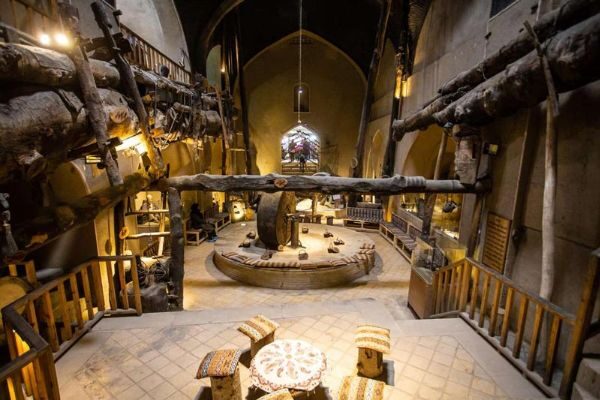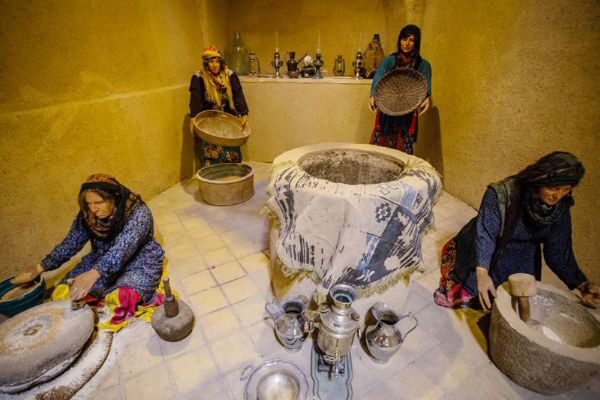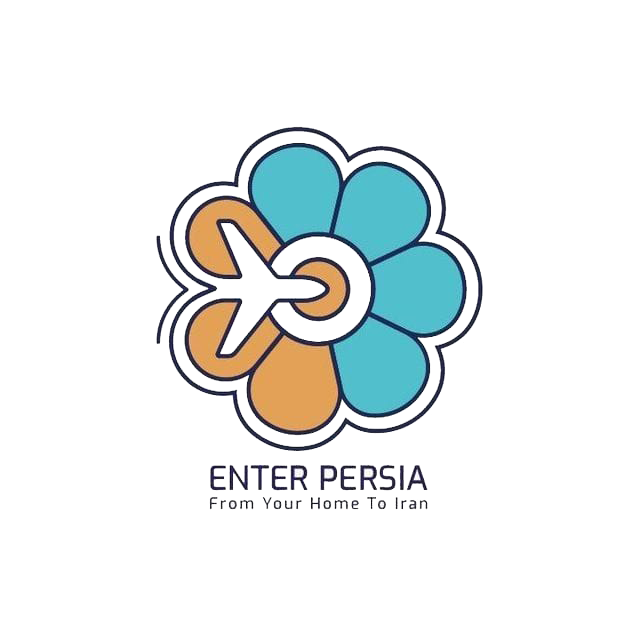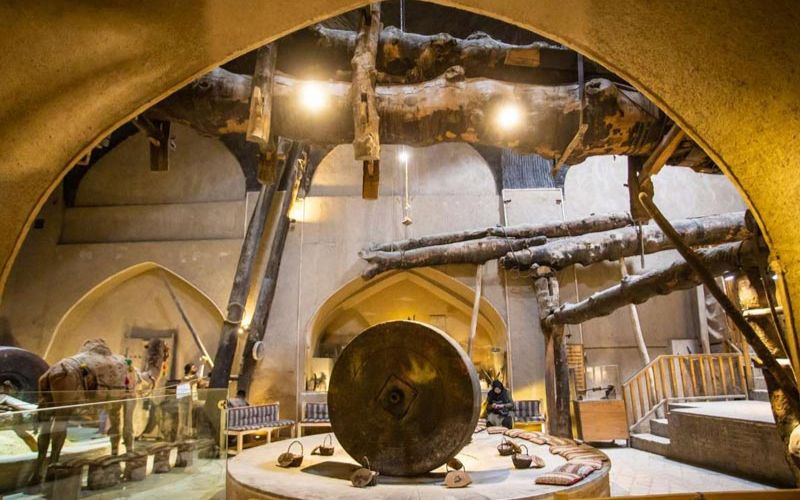The Assarkhane was referred to special mills, which were used to grind stuff such as turmeric and pepper in the ancient cities of Iran. In the past, the person who extracted the oil from the oilseeds was called Assar and this job was called Assari. In ancient times, Assari was considered one of the most important occupations. The word Assarkhane means the place where they extracting. The operation of these Assarkhanes is similar to that of oil-pressing factories. These early Assarkhanes were also called “choughangari”.
The Assarkhanes had several entrances; A special entrance for buyers that should be clean and tidy, and another special entrance for importing oilseeds and animal crossings and entrances for guests and special customers such as merchants and traders, and sometimes a special entrance for workers.
Oil extraction was an important job in the old days. In the time of Darius, the Achaemenid king, sesame was one of the goods exported from Iran to Egypt. During the Safavid period, this industry, like other industries and arts in that period, achieved a significant boom both in terms of industry and architecture.
According to archaeologists, based on discoveries, extracting oil seeds in Iran goes back to seven thousand years ago and it was carried out with simple tools. The extracted oil was used in mosques, schools, and homes, thus making these places very important and even sacred to people.
There have been stories about the sanctity of AssarKhaneh. If the transportation of the big wooden columns of AssarKhaneh in the narrow alleys of Isfahan caused some damages in buildings, instead of complaining, people would take it as a blessing.
Isfahan Shahi Assarkhaneh
One of the most famous remaining Assarkhanes in Isfahan is the Shahi Assarkhaneh, which was built in 1021 AH at the same time as the construction of the Qeysarriyeh Bazaar and the school of Mullah Abdullah by order of Shah Abbas I.
This AssarKhaneh has an area of about 380 square meters; The area used to be about 1,800 square meters, but now places such as “Shotorkhan”, “Yard” and Entrance of merchants have been destroyed, leaving only one “Tirkhaneh” and two storerooms in the eastern part of the “Tirkhaneh” on two floors.

The central space of the Assarkhaneh was built with a double-high ceiling measuring 11 meters, comprising three dome-shaped spaces with room for a carrier. The roof is arched and light is provided by the skylights. The domed roofs kept the area cool for oil storage. The walls and ceilings are made of bricks. Due to its usage, the Brick walls and ceilings are made without the use of windows, frameworks, paneling, and decorations.
The Assarkhaneh had various entrances. There were several doors in The Assarkhaneh because each door belonged to a group. For example, one door to enter the customer and another door for workers to enter; This indicates that each door has its own function.
From 1340 to 1349 SH, an electric motor was used to move the big beam and rotate the millstone and After that, due to the industrialization of this profession and the existence of mechanized equipment, it was not economical to continue the work and the Assarkhaneh was closed for 30 years.
Shahi Assarkhaneh has been operating since 1392 SH as the first specialized base for studying popular culture in the country. Oral history workshops are also held at this place. Thus, this Assarkhaneh became a small museum and in 2017, it won the ICOM World Award (International Council of Museums) as the best small museum in the country.
Isfahan Shahi Assarkhaneh is considered as a historical and economic monument of the Safavid era in Isfahan and It proves that Isfahan, as the capital in the Safavid era, was an industrial city with a factory.
Different parts of the Assarkhaneh
The main space of Assarkhaneh has five parts: Counter (entrance), Yard, Camel Stable, Warm Room and Tirkhaneh.
Counter: The entrance of the Assarkhaneh.
Yard: for delivery and storage of seeds.
Camel Stable: A large space that was mostly used for two purposes; To keep the animals which moved the millstones and It also plays the role of a dock so that the imported loads can be imported first and then transferred to other parts.
Warm Room: The top floor is known as the “warm house” where the oil seeds were cleaned and roasted.
Tirkhaneh: Tirkhaneh or Beam room is the main part of the Assarkhaneh. The final oil extraction operation was performed at this place. There are two large thick beams made of sycamore wood, a pulley and a wooden lever, a well called “Tilueh”, the bottom of which is made of gutters and a jar for storing oil, and the 5-meter-long “Espar” wall is made of wooden coils.
Grain storeroom: It is a place that should be safe from the access of animals and vermin, the doors of this section are always closed and the grains are entered and exited through the conduit that were on the wall. The storerooms on the east side of the Assarkhaneh were built on two floors, and the upper floors were used to store and roast the seeds, and the lower floors were used to grind the seeds and store the oil.
There were also rooms, which mostly housed guests, most of whom were merchants.
Oil extracting process and operation of the Assarkhaneh
- First, oil seeds were imported from the yard to the counter and classified according to their type of consumption (food, fuel, medicine, soap making, coloring, etc.).
- The seeds were transferred to the warm room and were roasted by fire to make them crispy and brittle. “Ton” was a special place for roasting oilseeds on the second floor of the Assarkhaneh.
- The seeds enter the milling section and are moved by a stone that was tied to the camel’s back by a long wooden pole to be crushed and softened. camel’s eyes were closed so that they would not get vertigo.
- Some water was added to the crushed seeds to form a paste, which was called “kale” paste.
- Masses of paste were spread on the woven trays of palm tree called “Kupi”.
- One by one, the “Kupies” were stacked on top of each other in a pile (a long vertical cylinder with a wooden wall).
- A cylindrical piece of wood called “Gerdeh” was placed on the last “Kupi”, the center of which was made of metal.
- Using a small oil extracting beam called a “Karmale”, whose head was fixed to the opposite wall and pulled down by a large rock, they put a little pressure on the “Kupies” to provide the work for the large beam. Then they removed the small beam and put it aside.
- Adding a few more circular sticks to the last “Kupi”, they pulled down the bottom of the large beam to compress the “Kupies” in the same way as the small beam to put a lot of pressure on the “Kupies” And all the oil comes out of the paste and enters the fixed vat inside the pit. After oil extraction, the oils were transferred to large vats and the vats were stored in the storeroom and inside the wall (due to the proper temperature).
- After the oil extraction operation, the “Kupies” were removed and the remaining pulp was ground from the oilseeds and used as natural fertilizer and animal feed.
Statues and figures in the Museum
nowadays, the museum of the Assarkhaneh is very beautifully designed, and by entering it, you can easily imagine the Assarkhaneh in operation alive. Eight sculptures have been erected in the space of the Assarkhaneh. A camel statue with a millstone attached to it to show that in the past the stone was rotated by a camel and 7 statues of men that are symbolically placed in different places.




Comment (0)